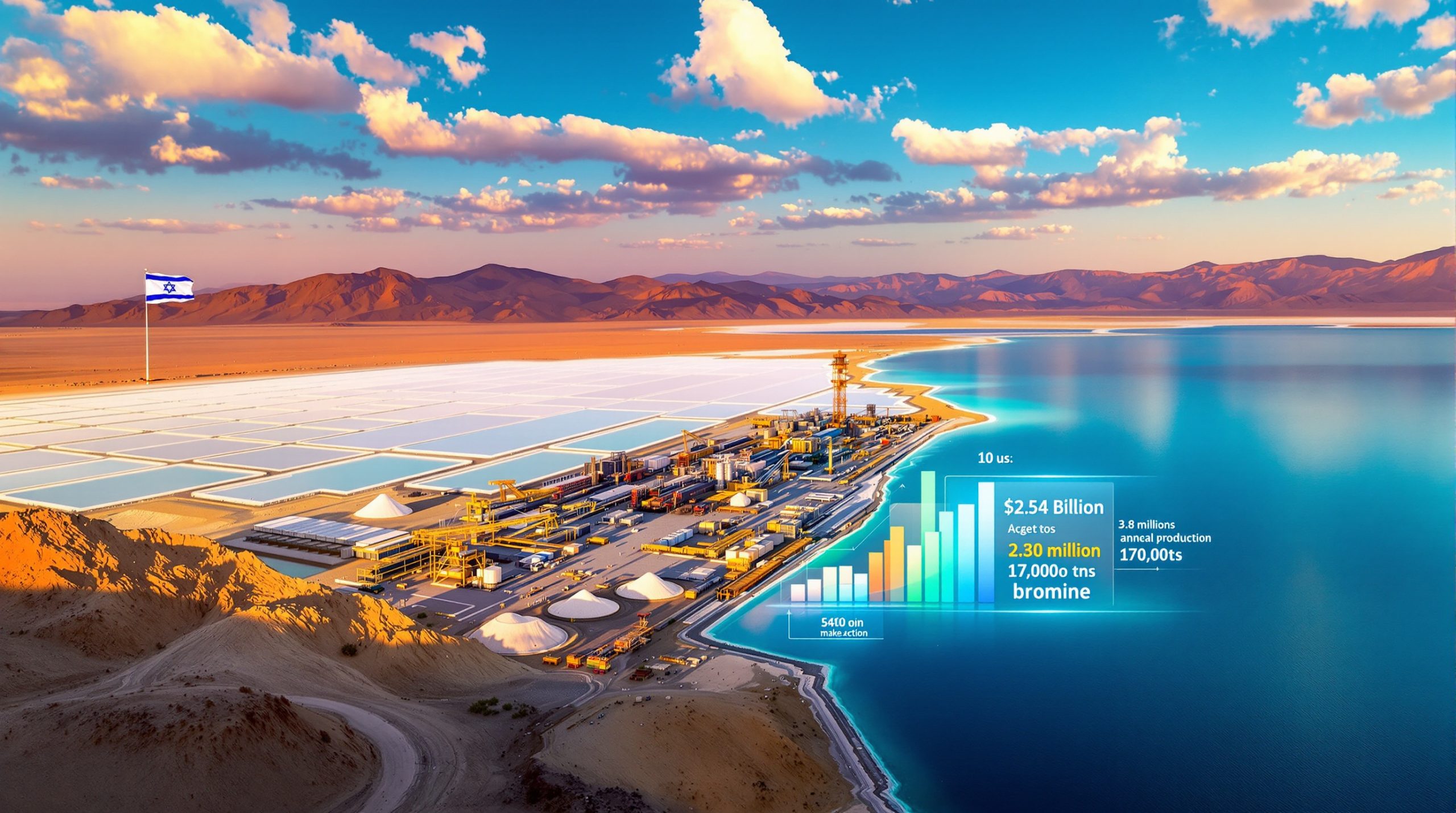The Critical Minerals Supply Chain Crisis
The United States faces an unprecedented vulnerability in its critical minerals supply chain, with antimony representing one of the most strategically important gaps. This metallic element serves as a cornerstone for defense applications, semiconductor manufacturing, and advanced energy storage systems, yet domestic production has remained virtually nonexistent for decades.
Recent developments highlight the urgency of this situation. Private company Sunshine Silver Mining and Refining has announced plans to revive one of America's most storied silver mines and build the country's only large-scale, permitted Sunshine Silver US antimony refinery. The facility is already permitted to process multiple metals and is being upgraded to handle antimony, a mineral deemed essential for US national security and energy resilience.
Current import patterns reveal the depth of American dependency. Furthermore, antimony is imported almost entirely from China and Russia, creating significant geopolitical risks for domestic industries amid growing US-China trade tensions. The US government has identified antimony as one of the highest-priority minerals for domestic sourcing under recent executive orders to bolster supply chain security.
What Makes Antimony Essential for National Security?
Defense and Military Applications
Antimony's unique properties make it indispensable for military hardware production. The metal enhances the hardness of lead alloys used in ammunition manufacturing, while its flame-retardant characteristics prove crucial for military vehicle components and protective equipment. Defense contractors rely heavily on consistent antimony supplies to maintain production schedules for critical military systems.
Industrial applications span beyond basic ammunition production. In addition, antimony compounds serve essential roles in specialised military electronics, where their semiconductor properties enable advanced guidance systems and communication equipment. The element's ability to withstand extreme temperatures makes it valuable for aerospace applications and high-performance military hardware.
Semiconductor and Technology Manufacturing
Modern semiconductor fabrication processes depend on antimony compounds for creating specialised electronic components. The element's role extends beyond traditional electronics into emerging technologies, including 5G infrastructure components and artificial intelligence hardware systems. As technological advancement accelerates, antimony demand from the semiconductor sector continues expanding rapidly.
The integration of antimony into advanced manufacturing processes requires consistent quality and supply reliability. Disruptions to antimony availability can cascade through technology supply chains, affecting everything from consumer electronics to critical infrastructure components. This dependency underscores the strategic importance of establishing reliable domestic sources.
Energy Storage and Grid Infrastructure
Advanced battery technologies, particularly those designed for grid-scale energy storage, incorporate antimony-based materials to improve performance and longevity. These applications become increasingly vital as renewable energy adoption grows and grid modernisation efforts intensify across the United States, creating significant energy security challenges.
Grid storage batteries utilising antimony compounds demonstrate superior cycling capabilities and thermal stability compared to conventional alternatives. As utilities expand renewable energy integration, the demand for reliable grid storage solutions incorporating antimony continues growing, making domestic production increasingly critical for energy security.
How Has Import Dependency Created Strategic Vulnerabilities?
China's Market Dominance and Export Restrictions
International market dynamics have created concerning dependencies for American manufacturers. While specific percentages vary, the overwhelming majority of US antimony supplies originate from foreign sources, particularly China and Russia. This concentration creates multiple layers of vulnerability during geopolitical tensions or trade disputes.
Recent export restrictions and market volatility have demonstrated the fragility of international antimony supply chains. Manufacturing facilities dependent on consistent antimony deliveries face production disruptions when geopolitical events interfere with normal trade patterns. These disruptions highlight the urgent need for domestic alternatives as part of a broader critical minerals strategy.
Economic and Supply Chain Implications
Import dependency creates multiple layers of vulnerability beyond simple availability concerns. Price volatility, transportation disruptions, and currency fluctuations all compound the challenges faced by American manufacturers requiring consistent antimony supplies. These factors directly impact production costs and strategic planning capabilities across multiple industries.
Transportation logistics further complicate antimony supply chains. Consequently, international shipping delays, port congestion, and customs processing can create weeks or months of uncertainty for manufacturers with tight production schedules. Domestic production would eliminate these logistical vulnerabilities while providing more predictable supply costs.
What Is the Sunshine Silver US Antimony Refinery Project?
Project Overview and Strategic Positioning
The Sunshine Silver Mining and Refining Company represents America's most ambitious attempt to establish domestic antimony production capabilities. This privately-held enterprise, supported by billionaire Thomas Kaplan's Electrum Group, aims to create the nation's only large-scale, permitted antimony refining facility representing a significant milestone in the evolution in mining.
The company closed a $75 million equity financing round in September, led by its majority shareholder Electrum Silver US. This substantial investment demonstrates serious commitment to developing domestic antimony production capabilities. The financing supports accelerated development of both mining operations and refinery infrastructure.
| Financial Investment Overview | |
|---|---|
| Recent Equity Financing | $75 million (September 2025) |
| Existing Infrastructure Value | $600 million |
| Historical Development Spending | $250 million (since 2011) |
| Target First Production | 2028 |
Location and Infrastructure Advantages
Situated in Idaho's historic Silver Valley, the project benefits from over $600 million in existing infrastructure investments. This established foundation includes processing facilities, transportation networks, and utility connections that significantly reduce development timelines and capital requirements compared to greenfield projects.
The Silver Valley location provides multiple strategic advantages beyond existing infrastructure. However, the region possesses established mining expertise, available workforce, and regulatory familiarity that streamline development processes. Transportation connections enable efficient distribution of finished products to major industrial markets.
Electrum has expanded the property's land position fourfold since acquiring the asset in 2011, now controlling the largest mineral rights package in the district. For instance, this expanded footprint provides long-term resource security and development flexibility that support sustained operations and aligns with strategic antimony financing initiatives.
Integrated Operations Model
The facility is designed as a fully integrated operation capable of producing multiple critical minerals simultaneously. Beyond antimony, the refinery will process silver, gallium, and germanium, creating a diversified revenue stream while addressing multiple supply chain vulnerabilities through a single operational platform.
This integrated approach maximises operational efficiency while spreading development costs across multiple product streams. Furthermore, the facility is envisioned as the sole fully integrated US operation producing and processing silver, antimony, gallium, and germanium, positioning it as a strategic hub for critical minerals production.
The project represents a unique opportunity to address multiple critical mineral supply gaps through a single, strategically located facility with established infrastructure advantages.
How Will the Refinery Address US Antimony Demand?
Production Capacity and Timeline Projections
The Sunshine Silver US antimony refinery could supply approximately 40% of America's yearly antimony demand by 2028, with projections indicating potential coverage rising to as much as 80% by 2031. These company projections represent significant progress toward domestic antimony independence, though actual production levels will depend on successful development execution.
Production Timeline and Market Impact:
- 2028: Target first production, addressing 40% of US antimony demand
- 2031: Potential coverage expansion to 80% of domestic demand
- Long-term: Establishing foundation for complete domestic supply security
The timeline reflects realistic development phases while addressing urgent supply security needs. Initial production targets focus on establishing operational reliability before scaling to maximum capacity. This phased approach reduces development risks while providing measurable progress toward supply independence.
Third-Party Processing Capabilities
The refinery's design incorporates significant third-party processing capacity, enabling it to serve as a regional hub for antimony concentrate processing. This capability maximises facility utilisation while supporting smaller mining operations that lack integrated refining capabilities.
Third-party processing creates additional revenue streams while strengthening the broader domestic antimony supply network. In addition, by offering processing services to other mining operations, the facility can operate at higher capacity utilisation rates while supporting industry-wide domestic production growth.
Regional hub capabilities position the facility to process concentrates from various domestic sources, creating a centralised processing infrastructure that benefits the entire American antimony sector. This approach encourages domestic mining development by providing reliable processing alternatives.
Supply Chain Integration Opportunities
Strategic partnerships with domestic mining projects could create a fully integrated American antimony supply chain. Such arrangements would eliminate foreign dependency while supporting multiple domestic mining operations through coordinated development approaches.
Integration opportunities extend beyond simple processing agreements to include joint development projects, shared infrastructure investments, and coordinated market strategies. These partnerships could accelerate domestic antimony sector development while reducing individual project risks.
What Are the Technical Specifications and Capabilities?
Processing Technology and Equipment
The refinery employs advanced metallurgical processes designed to handle multiple feed materials efficiently. Modern equipment configurations enable flexible processing schedules that can accommodate varying concentrate qualities and production requirements, as detailed by Mining Journal's coverage of the project.
Technical capabilities extend beyond antimony processing to include silver, gallium, and germanium production. The project contains one of the world's highest-grade undeveloped silver deposits, with indicated resources of 112 million ounces grading 1,067 grams per tonne.
Resource and Production Specifications:
- Silver Resources: 112 million ounces indicated at 1,067 g/t
- Projected Silver Production: 7.6 million ounces annually (first five years)
- Historical Production: 360 million ounces since early 20th century
- US Market Impact: 20%+ increase in total US silver output
Quality Standards and Certifications
Production standards align with established industry specifications for refined metals, ensuring compatibility with existing industrial supply chains. Comprehensive quality control systems maintain consistent output specifications across all product lines.
The facility's existing permits for multiple metal processing provide regulatory advantages that accelerate antimony production implementation. These established permissions reduce development timelines while ensuring compliance with environmental and safety requirements, according to Mining Technology's analysis.
Environmental and Safety Protocols
Modern environmental management systems ensure compliance with federal and state regulations while minimising ecological impact. The company is progressing engineering and feasibility work to restore mining infrastructure, surface facilities, and water treatment systems.
A comprehensive feasibility study targeted for early 2027 will finalise environmental protocols and operational specifications. This study will establish definitive production capabilities, environmental safeguards, and safety procedures for full-scale operations.
How Does This Impact the Broader Mining Industry?
Domestic Mining Revival Implications
The refinery's development signals potential revival of American critical minerals mining, encouraging exploration and development of domestic antimony deposits. This trend could extend to other strategic minerals currently dominated by foreign suppliers.
Exploration drilling has identified several new silver-rich zones at the Sunshine property, suggesting potential for resource growth beyond current mine plans. These discoveries demonstrate the ongoing mineral potential of established mining districts when supported by modern exploration techniques.
The project's success could catalyse similar developments across multiple critical mineral sectors. By demonstrating the viability of domestic critical mineral production, the Sunshine Silver US antimony refinery establishes precedents that encourage additional private investment in American mining capabilities.
Investment and Economic Development
The project represents significant private investment in American manufacturing capabilities, creating employment opportunities and supporting regional economic development. Multiplier effects extend throughout local supply chains and service providers.
Regional economic benefits include direct employment during construction and operations phases, along with indirect benefits for supporting businesses and services. However, the Silver Valley's established mining infrastructure provides workforce capabilities that support project development.
Investment patterns demonstrate private sector confidence in domestic critical minerals development when supported by appropriate regulatory frameworks and existing infrastructure advantages.
Technology Transfer and Innovation
Advanced processing technologies developed for the facility could benefit other domestic mining operations, fostering innovation and competitiveness across the broader minerals processing sector.
Integrated processing capabilities for multiple critical minerals create opportunities for technological advancement and operational optimisation. These innovations could establish new standards for domestic critical mineral production efficiency.
What Are the Long-Term Strategic Implications?
National Security Enhancement
Domestic antimony production directly strengthens national security by reducing dependency on potentially unreliable foreign suppliers. This capability becomes particularly crucial during geopolitical tensions or trade disputes that could disrupt international supply chains.
Strategic autonomy in critical mineral supplies enables more independent foreign policy decisions while protecting domestic industries from supply manipulation. Consequently, the ability to maintain defence production capabilities regardless of international trade conditions represents a fundamental national security advantage.
Economic Resilience Building
Establishing domestic production capabilities creates economic resilience against external shocks while supporting American manufacturing competitiveness. Reduced import costs and supply chain risks benefit multiple downstream industries.
Economic benefits extend beyond direct cost savings to include enhanced supply predictability, reduced currency exposure, and elimination of international transportation risks. These advantages strengthen the competitiveness of American manufacturers across multiple sectors.
Future Expansion Potential
Success with antimony production could catalyse similar projects for other critical minerals, gradually rebuilding America's domestic processing capabilities across multiple strategic materials.
The integrated processing model demonstrates scalable approaches for addressing multiple critical mineral supply gaps through coordinated development strategies. Furthermore, this approach could serve as a template for comprehensive critical mineral supply security programmes.
Disclaimer: The production timelines and capacity projections mentioned in this article represent company estimates and forecasts that are subject to successful project development, regulatory approvals, market conditions, and operational execution. Actual results may vary significantly from projected outcomes.
The Sunshine Silver US antimony refinery represents more than a single industrial project—it embodies a strategic shift toward domestic critical minerals independence. As the facility progresses toward 2028 production targets, its success could establish a template for revitalising American mineral processing capabilities across multiple strategic materials.
The project's integrated approach, combining existing infrastructure advantages with modern processing technologies, demonstrates how private investment can address national security priorities while creating sustainable business models. Success in achieving domestic antimony production could catalyse broader efforts to reduce foreign dependency across the entire critical minerals spectrum, establishing a foundation for long-term supply security and economic resilience.
Could Critical Minerals Supply Chain Disruptions Impact Your Investment Strategy?
Discovery Alert's proprietary Discovery IQ model provides instant notifications on significant ASX critical minerals discoveries, empowering subscribers to identify actionable opportunities ahead of broader market recognition. Explore how historic discoveries have generated substantial returns and begin your 30-day free trial today to secure your market-leading advantage in this rapidly evolving sector.




